Paper Menu >>
Journal Menu >>
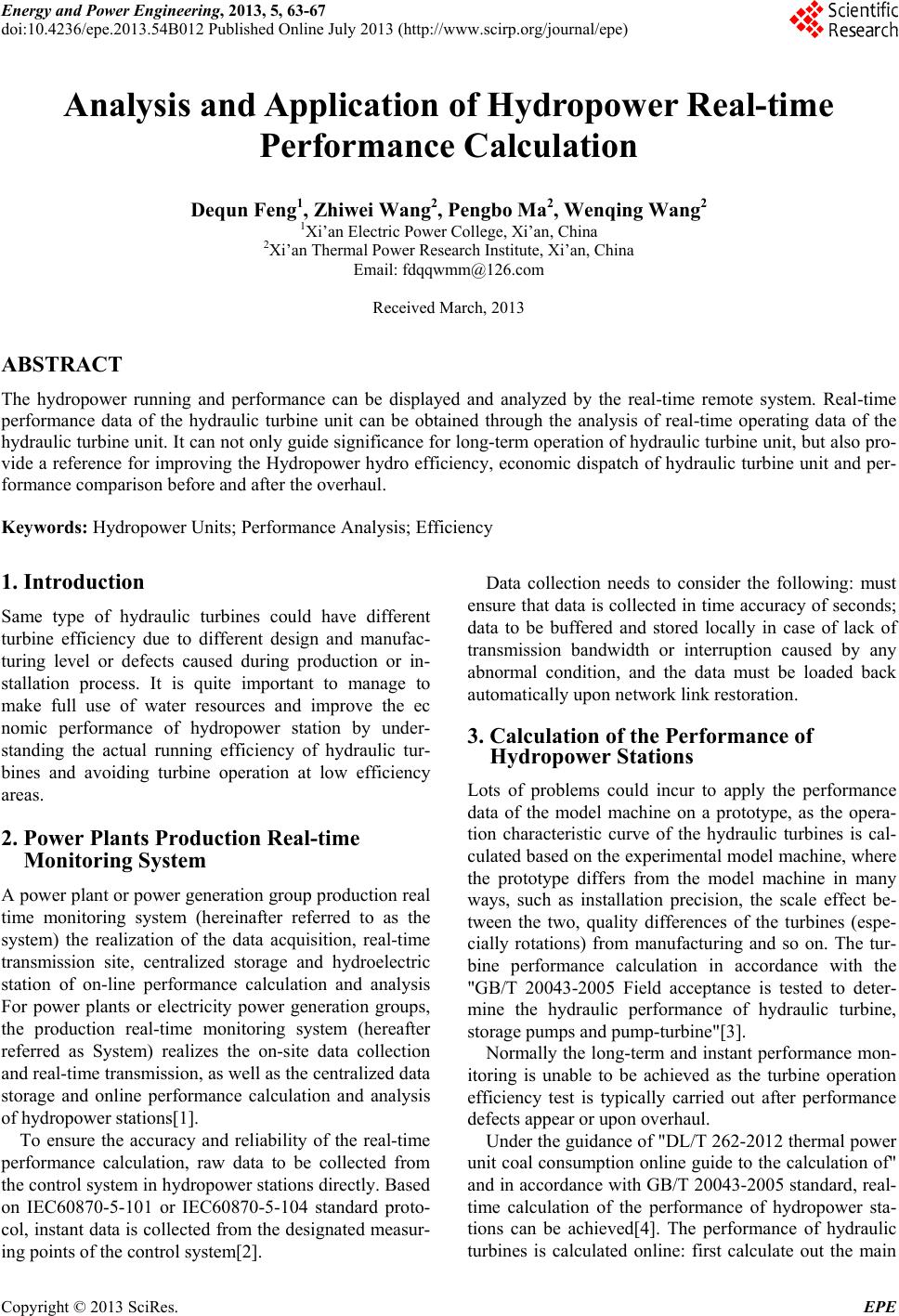 Energy and Power Engineering, 2013, 5, 63-67 doi:10.4236/epe.2013.54B012 Published Online July 2013 (http://www.scirp.org/journal/epe) Analysis and Application of Hydropower Real-time Performance Calculation Dequn Feng1, Zhiwei Wang2, Pengbo Ma2, Wenqing Wang2 1Xi’an Electric Power College, Xi’an, China 2Xi’an Thermal Power Research Institute, Xi’an, China Email: fdqqwmm@126.com Received March, 2013 ABSTRACT The hydropower running and performance can be displayed and analyzed by the real-time remote system. Real-time performance data of the hydraulic turbine unit can be obtained through the analysis of real-time operating data of the hydraulic turbine unit. It can not only guide significance for long-term operation of hydraulic turbine unit, but also pro- vide a reference for improving the Hydropower hydro efficiency, economic dispatch of hydraulic turbine unit and per- formance comparison before and after the overhaul. Keywords: Hydropower Units; Performance Analysis; Efficiency 1. Introduction Same type of hydraulic turbines could have different turbine efficiency due to different design and manufac- turing level or defects caused during production or in- stallation process. It is quite important to manage to make full use of water resources and improve the ec nomic performance of hydropower station by under- standing the actual running efficiency of hydraulic tur- bines and avoiding turbine operation at low efficiency areas. 2. Power Plants Production Real-time Monitoring System A power plant or power generation group production real time monitoring system (hereinafter referred to as the system) the realization of the data acquisition, real-time transmission site, centralized storage and hydroelectric station of on-line performance calculation and analysis For power plants or electricity power generation groups, the production real-time monitoring system (hereafter referred as System) realizes the on-site data collection and real-time transmission, as well as the centralized data storage and online performance calculation and analysis of hydropower stations[1]. To ensure the accuracy and reliability of the real-time performance calculation, raw data to be collected from the control system in hydropower stations directly. Based on IEC60870-5-101 or IEC60870-5-104 standard proto- col, instant data is collected from the designated measur- ing points of the control system[2]. Data collection needs to consider the following: must ensure that data is collected in time accuracy of seconds; data to be buffered and stored locally in case of lack of transmission bandwidth or interruption caused by any abnormal condition, and the data must be loaded back automatically upon network link restoration. 3. Calculation of the Performance of Hydropower Stations Lots of problems could incur to apply the performance data of the model machine on a prototype, as the opera- tion characteristic curve of the hydraulic turbines is cal- culated based on the experimental model machine, where the prototype differs from the model machine in many ways, such as installation precision, the scale effect be- tween the two, quality differences of the turbines (espe- cially rotations) from manufacturing and so on. The tur- bine performance calculation in accordance with the "GB/T 20043-2005 Field acceptance is tested to deter- mine the hydraulic performance of hydraulic turbine, storage pumps and pump-turbine"[3]. Normally the long-term and instant performance mon- itoring is unable to be achieved as the turbine operation efficiency test is typically carried out after performance defects appear or upon overhaul. Under the guidance of "DL/T 262-2012 thermal power unit coal consumption online guide to the calculation of" and in accordance with GB/T 20043-2005 standard, real- time calculation of the performance of hydropower sta- tions can be achieved[4]. The performance of hydraulic turbines is calculated online: first calculate out the main Copyright © 2013 SciRes. EPE 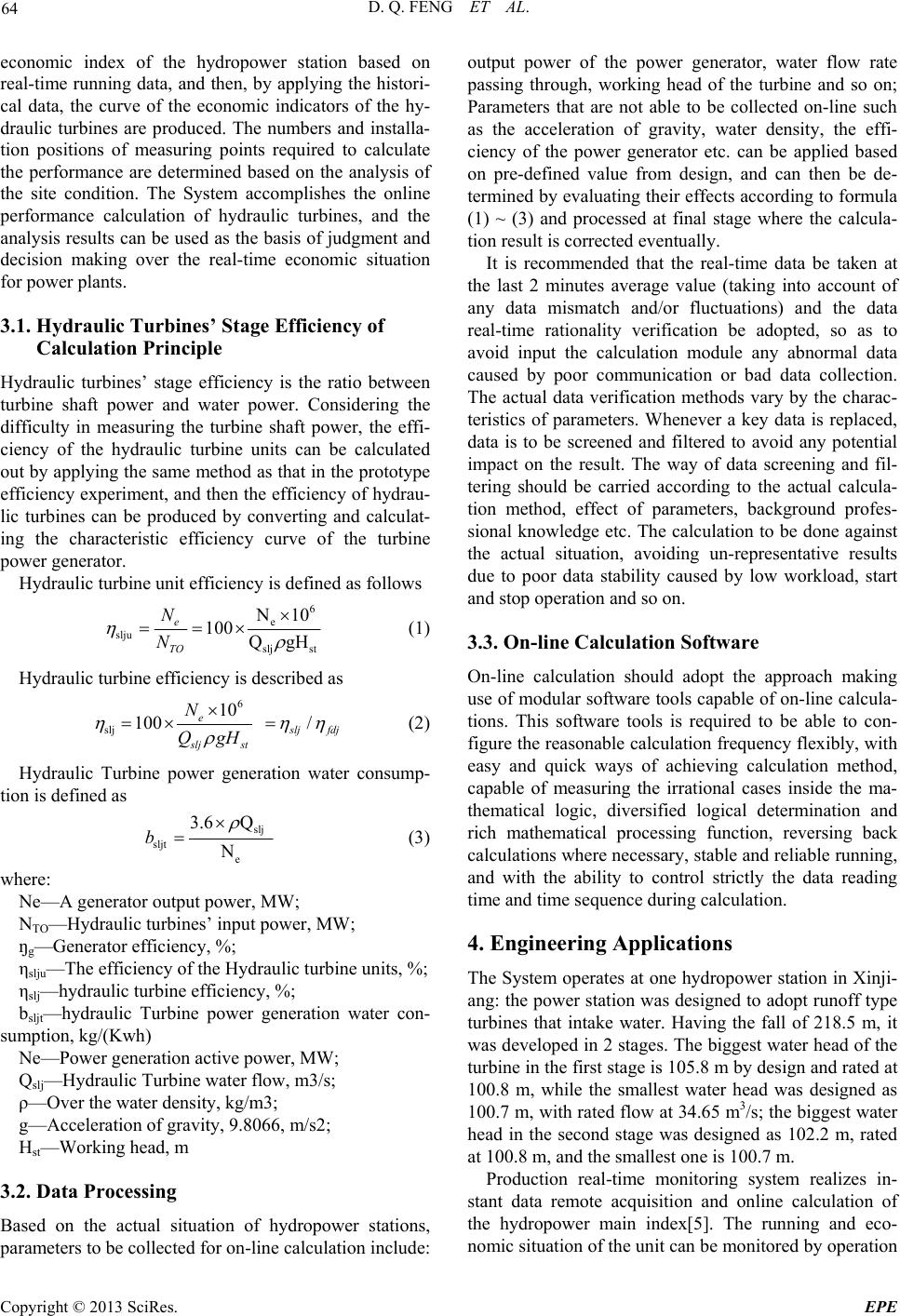 D. Q. FENG ET AL. 64 economic index of the hydropower station based on real-time running data, and then, by applying the histori- cal data, the curve of the economic indicators of the hy- draulic turbines are produced. The numbers and installa- tion positions of measuring points required to calculate the performance are determined based on the analysis of the site condition. The System accomplishes the online performance calculation of hydraulic turbines, and the analysis results can be used as the basis of judgment and decision making over the real-time economic situation for power plants. 3.1. Hydraulic Turbines’ Stage Efficiency of Calculation Principle Hydraulic turbines’ stage efficiency is the ratio between turbine shaft power and water power. Considering the difficulty in measuring the turbine shaft power, the effi- ciency of the hydraulic turbine units can be calculated out by applying the same method as that in the prototype efficiency experiment, and then the efficiency of hydrau- lic turbines can be produced by converting and calculat- ing the characteristic efficiency curve of the turbine power generator. Hydraulic turbine unit efficiency is defined as follows 6 e slju slj st N10 100 QgH e TO N N (1) Hydraulic turbine efficiency is described as 6 slj 10 100 / e s lj fdj slj st N QgH (2) Hydraulic Turbine power generation water consump- tion is defined as slj sljt e 3.6Q N b (3) where: Ne—A generator output power, MW; NTO—Hydraulic turbines’ input power, MW; ŋg—Generator efficiency, %; ηslju—The efficiency of the Hydraulic turbine units, %; ηslj—hydraulic turbine efficiency, %; bsljt—hydraulic Turbine power generation water con- sumption, kg/(Kwh) Ne—Power generation active power, MW; Qslj—Hydraulic Turbine water flow, m3/s; ρ—Over the water density, kg/m3; g—Acceleration of gravity, 9.8066, m/s2; Hst—Working head, m 3.2. Data Processing Based on the actual situation of hydropower stations, parameters to be collected for on-line calculation include: output power of the power generator, water flow rate passing through, working head of the turbine and so on; Parameters that are not able to be collected on-line such as the acceleration of gravity, water density, the effi- ciency of the power generator etc. can be applied based on pre-defined value from design, and can then be de- termined by evaluating their effects according to formula (1) ~ (3) and processed at final stage where the calcula- tion result is corrected eventually. It is recommended that the real-time data be taken at the last 2 minutes average value (taking into account of any data mismatch and/or fluctuations) and the data real-time rationality verification be adopted, so as to avoid input the calculation module any abnormal data caused by poor communication or bad data collection. The actual data verification methods vary by the charac- teristics of parameters. Whenever a key data is replaced, data is to be screened and filtered to avoid any potential impact on the result. The way of data screening and fil- tering should be carried according to the actual calcula- tion method, effect of parameters, background profes- sional knowledge etc. The calculation to be done against the actual situation, avoiding un-representative results due to poor data stability caused by low workload, start and stop operation and so on. 3.3. On-line Cal cu l a ti o n S o f tw a r e On-line calculation should adopt the approach making use of modular software tools capable of on-line calcula- tions. This software tools is required to be able to con- figure the reasonable calculation frequency flexibly, with easy and quick ways of achieving calculation method, capable of measuring the irrational cases inside the ma- thematical logic, diversified logical determination and rich mathematical processing function, reversing back calculations where necessary, stable and reliable running, and with the ability to control strictly the data reading time and time sequence during calculation. 4. Engineering Applications The System operates at one hydropower station in Xinji- ang: the power station was designed to adopt runoff type turbines that intake water. Having the fall of 218.5 m, it was developed in 2 stages. The biggest water head of the turbine in the first stage is 105.8 m by design and rated at 100.8 m, while the smallest water head was designed as 100.7 m, with rated flow at 34.65 m3/s; the biggest water head in the second stage was designed as 102.2 m, rated at 100.8 m, and the smallest one is 100.7 m. Production real-time monitoring system realizes in- stant data remote acquisition and online calculation of the hydropower main index[5]. The running and eco- nomic situation of the unit can be monitored by operation Copyright © 2013 SciRes. EPE 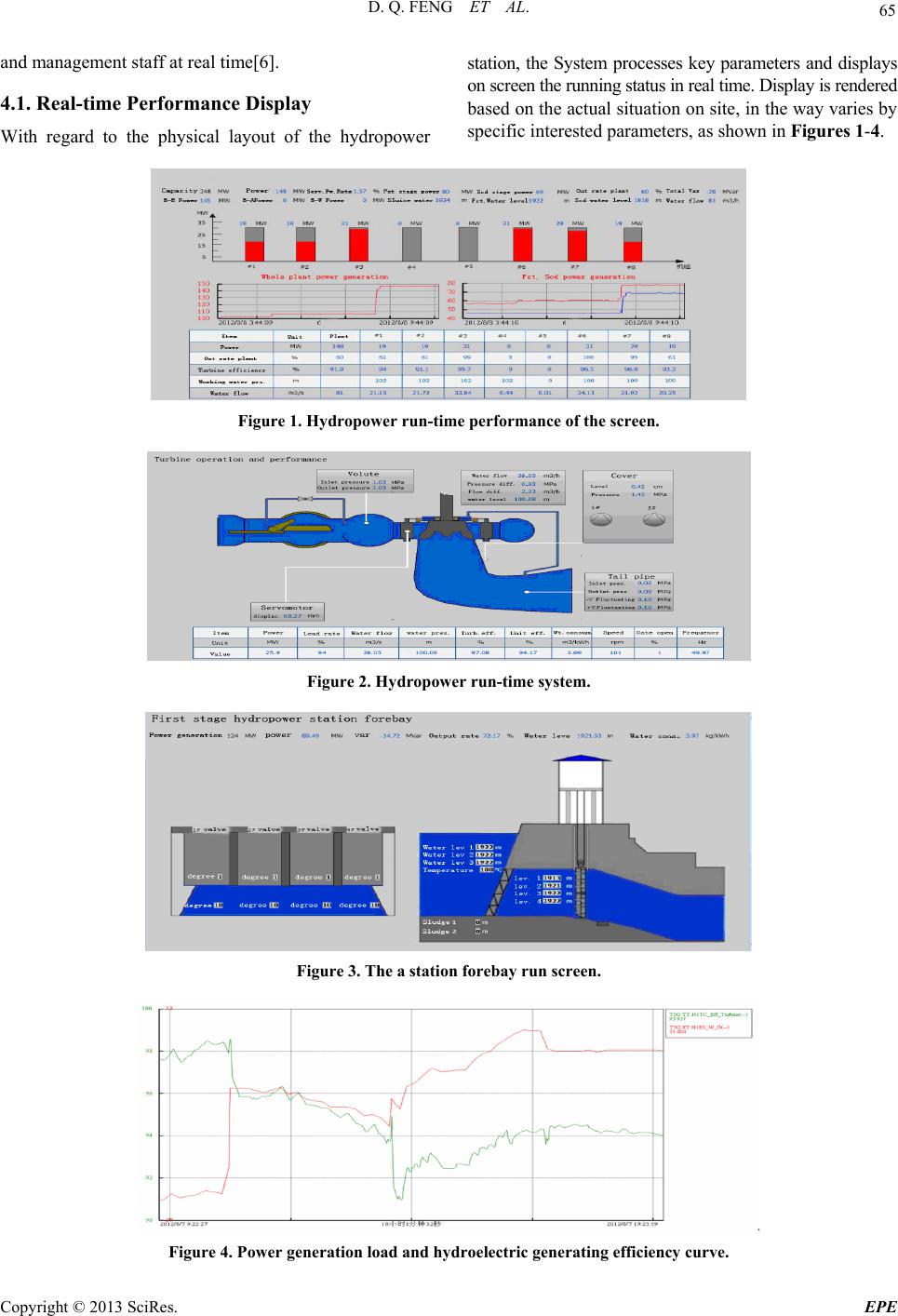 D. Q. FENG ET AL. Copyright © 2013 SciRes. EPE 65 and management staff at real time[6]. station, the System processes key parameters and displays on screen the running status in real time. Display is rendered based on the actual situation on site, in the way varies by specific interested parameters, as shown in Figures 1-4. 4.1. Real-time Performance Display With regard to the physical layout of the hydropower Figure 1. Hydropower run-time performance of the screen. Figure 2. Hydropower run-time system. Figure 3. The a station forebay run screen. Figure 4. Power generation load and hydroelectric generating efficiency curve. 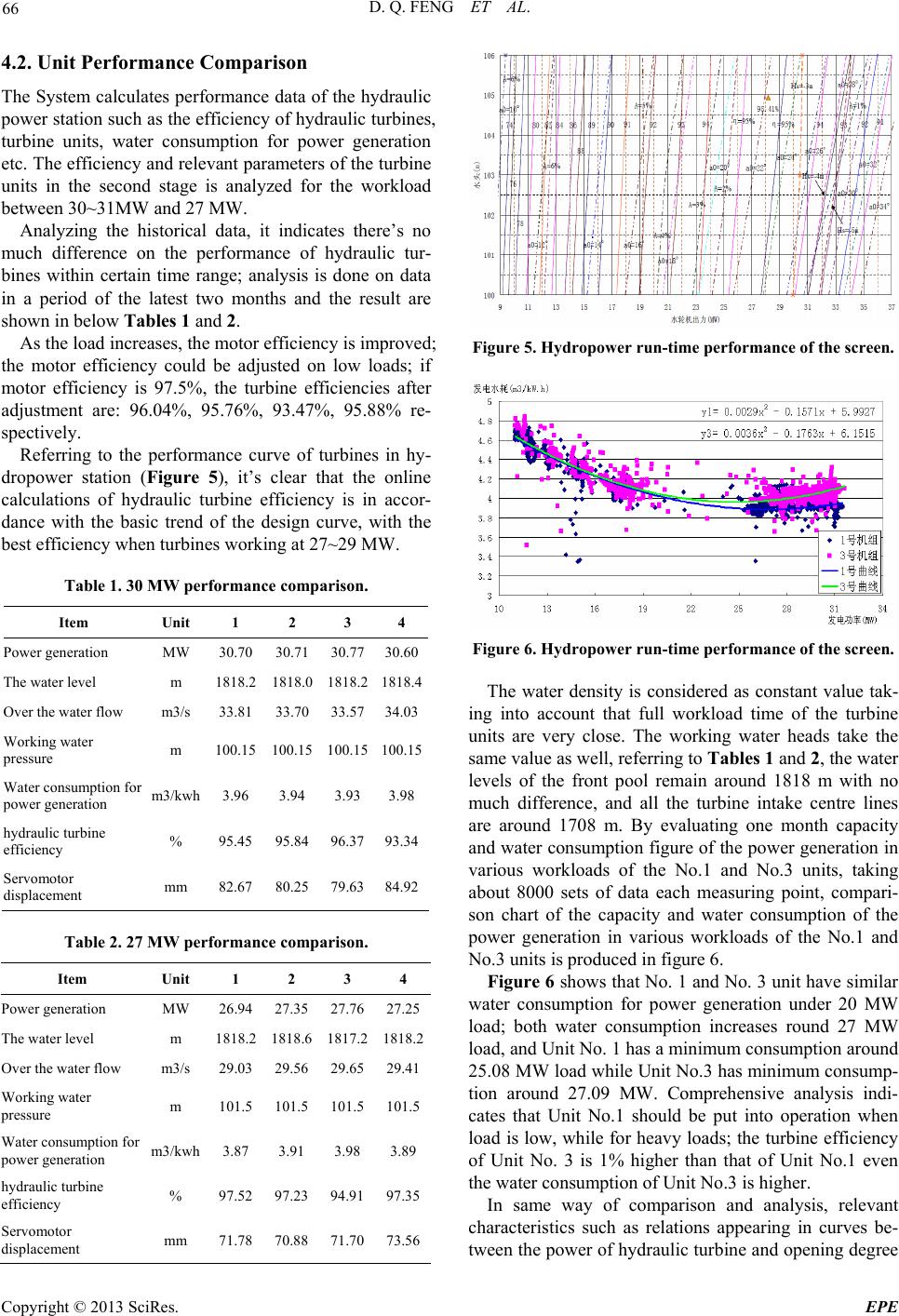 D. Q. FENG ET AL. 66 4.2. Unit Performance Comparison The System calculates performance data of the hydraulic power station such as the efficiency of hydraulic turbines, turbine units, water consumption for power generation etc. The efficiency and relevant parameters of the turbine units in the second stage is analyzed for the workload between 30~31MW and 27 MW. Analyzing the historical data, it indicates there’s no much difference on the performance of hydraulic tur- bines within certain time range; analysis is done on data in a period of the latest two months and the result are shown in below Tables 1 and 2. As the load increases, the motor efficiency is improved; the motor efficiency could be adjusted on low loads; if motor efficiency is 97.5%, the turbine efficiencies after adjustment are: 96.04%, 95.76%, 93.47%, 95.88% re- spectively. Referring to the performance curve of turbines in hy- dropower station (Figure 5), it’s clear that the online calculations of hydraulic turbine efficiency is in accor- dance with the basic trend of the design curve, with the best efficiency when turbines working at 27~29 MW. Table 1. 30 MW performance comparison. Item Unit 1 2 3 4 Power generation MW 30.70 30.71 30.7730.60 The water level m 1818.2 1818.0 1818.21818.4 Over the water flow m3/s 33.81 33.70 33.5734.03 Working water pressure m 100.15 100.15 100.15100.15 Water consumption for power generation m3/kwh 3.96 3.94 3.933.98 hydraulic turbine efficiency % 95.45 95.84 96.3793.34 Servomotor displacement mm 82.67 80.25 79.6384.92 Table 2. 27 MW performance comparison. Item Unit 1 2 3 4 Power generation MW 26.94 27.35 27.76 27.25 The water level m 1818.2 1818.6 1817.21818.2 Over the water flow m3/s 29.03 29.56 29.6529.41 Working water pressure m 101.5 101.5 101.5 101.5 Water consumption for power generation m3/kwh 3.87 3.91 3.98 3.89 hydraulic turbine efficiency % 97.52 97.23 94.91 97.35 Servomotor displacement mm 71.78 70.88 71.70 73.56 Figure 5. Hydropower run-time performance of the screen. Figure 6. Hydropower run-time performance of the screen. The water density is considered as constant value tak- ing into account that full workload time of the turbine units are very close. The working water heads take the same value as well, referring to Tables 1 and 2, the water levels of the front pool remain around 1818 m with no much difference, and all the turbine intake centre lines are around 1708 m. By evaluating one month capacity and water consumption figure of the power generation in various workloads of the No.1 and No.3 units, taking about 8000 sets of data each measuring point, compari- son chart of the capacity and water consumption of the power generation in various workloads of the No.1 and No.3 units is produced in figure 6. Figure 6 shows that No. 1 and No. 3 unit have similar water consumption for power generation under 20 MW load; both water consumption increases round 27 MW load, and Unit No. 1 has a minimum consumption around 25.08 MW load while Unit No.3 has minimum consump- tion around 27.09 MW. Comprehensive analysis indi- cates that Unit No.1 should be put into operation when load is low, while for heavy loads; the turbine efficiency of Unit No. 3 is 1% higher than that of Unit No.1 even the water consumption of Unit No.3 is higher. In same way of comparison and analysis, relevant characteristics such as relations appearing in curves be- tween the power of hydraulic turbine and opening degree Copyright © 2013 SciRes. EPE 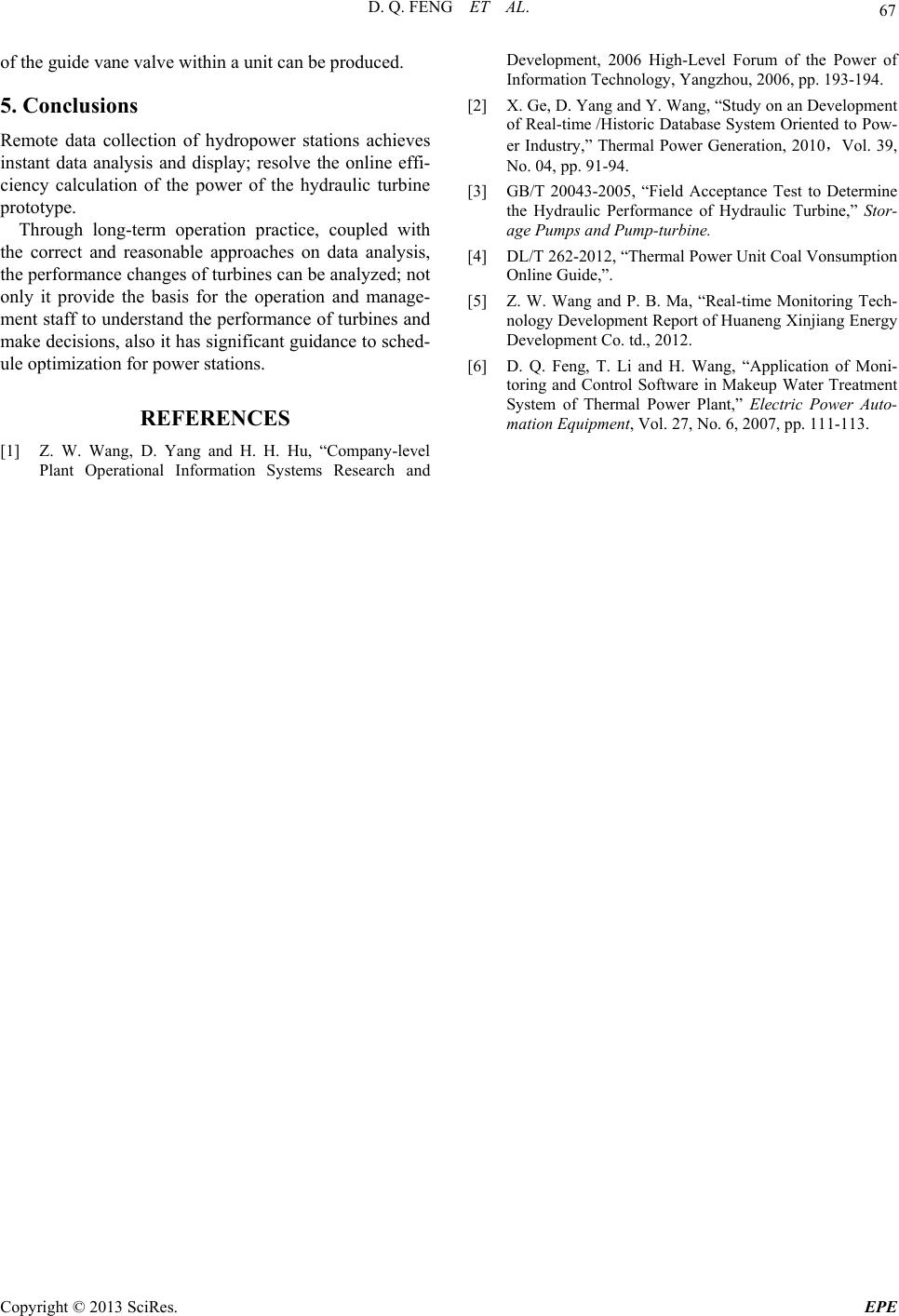 D. Q. FENG ET AL. 67 of the guide vane valve within a unit can be produced. 5. Conclusions Remote data collection of hydropower stations achieves instant data analysis and display; resolve the online effi- ciency calculation of the power of the hydraulic turbine prototype. Through long-term operation practice, coupled with the correct and reasonable approaches on data analysis, the performance changes of turbines can be analyzed; not only it provide the basis for the operation and manage- ment staff to understand the performance of turbines and make decisions, also it has significant guidance to sched- ule optimization for power stations. REFERENCES [1] Z. W. Wang, D. Yang and H. H. Hu, “Company-level Plant Operational Information Systems Research and Development, 2006 High-Level Forum of the Power of Information Technology, Yangzhou, 2006, pp. 193-194. [2] X. Ge, D. Yang and Y. Wang, “Study on an Development of Real-time /Historic Database System Oriented to Pow- er Industry,” Thermal Power Generation, 2010,Vol. 39, No. 04, pp. 91-94. [3] GB/T 20043-2005, “Field Acceptance Test to Determine the Hydraulic Performance of Hydraulic Turbine,” Stor- age Pumps and Pump-turbine. [4] DL/T 262-2012, “Thermal Power Unit Coal Vonsumption Online Guide,”. [5] Z. W. Wang and P. B. Ma, “Real-time Monitoring Tech- nology Development Report of Huaneng Xinjiang Energy Development Co. td., 2012. [6] D. Q. Feng, T. Li and H. Wang, “Application of Moni- toring and Control Software in Makeup Water Treatment System of Thermal Power Plant,” Electric Power Auto- mation Equipment, Vol. 27, No. 6, 2007, pp. 111-113. Copyright © 2013 SciRes. EPE |

